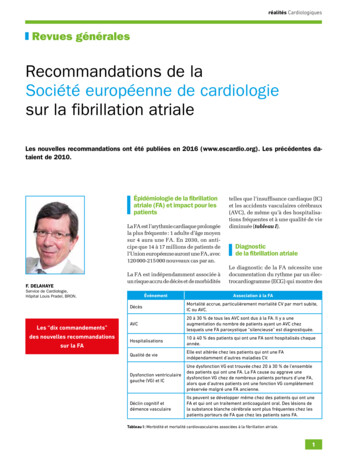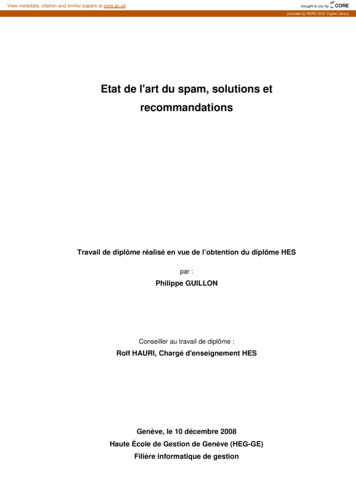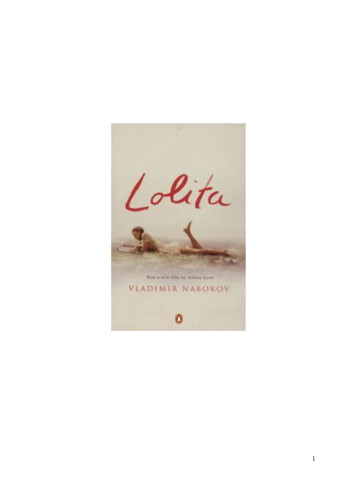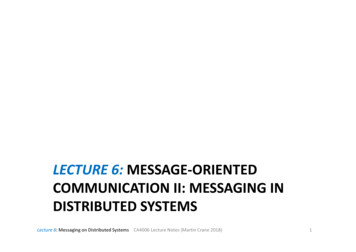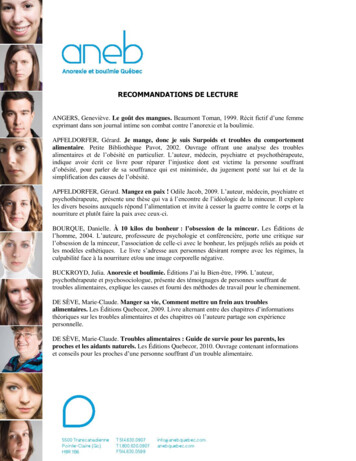
Transcription
RECOMMANDATIONS DE LECTUREANGERS, Geneviève. Le goût des mangues. Beaumont Toman, 1999. Récit fictif d’une femmeexprimant dans son journal intime son combat contre l’anorexie et la boulimie.APFELDORFER, Gérard. Je mange, donc je suis Surpoids et troubles du comportementalimentaire. Petite Bibliothèque Pavot, 2002. Ouvrage offrant une analyse des troublesalimentaires et de l’obésité en particulier. L’auteur, médecin, psychiatre et psychothérapeute,indique avoir écrit ce livre pour réparer l’injustice dont est victime la personne souffrantd’obésité, pour parler de sa souffrance qui est minimisée, du jugement porté sur lui et de lasimplification des causes de l’obésité.APFELDORFER, Gérard. Mangez en paix ! Odile Jacob, 2009. L’auteur, médecin, psychiatre etpsychothérapeute, présente une thèse qui va à l’encontre de l’idéologie de la minceur. Il exploreles divers besoins auxquels répond l’alimentation et invite à cesser la guerre contre le corps et lanourriture et plutôt faire la paix avec ceux-ci.BOURQUE, Danielle. À 10 kilos du bonheur : l’obsession de la minceur. Les Éditions del’homme, 2004. L’auteure, professeure de psychologie et conférencière, porte une critique surl’obsession de la minceur, l’association de celle-ci avec le bonheur, les préjugés reliés au poids etles modèles esthétiques. Le livre s’adresse aux personnes désirant rompre avec les régimes, laculpabilité face à la nourriture et/ou une image corporelle négative.BUCKROYD, Julia. Anorexie et boulimie. Éditions J’ai lu Bien-être, 1996. L’auteur,psychothérapeute et psychosociologue, présente des témoignages de personnes souffrant detroubles alimentaires, explique les causes et fourni des méthodes de travail pour le cheminement.DE SÈVE, Marie-Claude. Manger sa vie, Comment mettre un frein aux troublesalimentaires. Les Éditions Quebecor, 2009. Livre alternant entre des chapitres d’informationsthéoriques sur les troubles alimentaires et des chapitres où l’auteure partage son expériencepersonnelle.DE SÈVE, Marie-Claude. Troubles alimentaires : Guide de survie pour les parents, lesproches et les aidants naturels. Les Éditions Quebecor, 2010. Ouvrage contenant informationset conseils pour les proches d’une personne souffrant d’un trouble alimentaire.
FORGET, Raymonde. Maigrir sans obsession. Les Éditions JCL, 2000. Livre dans lequell’auteure, psychothérapeute en programmation neurolinguistique, présente une approche pourmaitriser son poids en se libérant de l’obsession de la nourriture et des privations. L’ouvrageinclue un carnet de bord contenant de nombreux exercices pour permettre au lecteur de porterréflexion sur sa propre situation et pour mettre en application les outils présentés.HÉNAULT, Anne-Marie. Plume, un jour je volerai. Les Éditions Francine Breton, 2003. Livrequi prend la forme du journal intime d’une adolescente souffrant d’anorexie. Récit touchant quidémontre bien la complexité des troubles alimentaires et comment ceux-ci peuvent prendreforme. Offre quelques pages d’informations théoriques et de conseils pour les proches.GUEVREMONT, Guylaine & LORTIE Marie-Claude. Mangez ! Un jeu d’enfant. Les Éditionsla Presse, 2008. Livre explorant divers comportements des au niveau de l’alimentation chez lesenfants et les adolescents afin d’aider les parents à les accompagner vers une relationharmonieuse avec la nourriture et le corps.L. Cynthia, Journal d’Ana-Morphose. 2011. Récit d’une adolescente souffrant d’anorexie.LALANCETTE, Marie-France. Adieu régime, bonjour la vie : Pour en finir avec le culte de laminceur.Les Éditions de l’Homme, 2007. Ouvrage explorant les causes de diverscomportements au niveau de l’alimentation dont la compulsion et la restriction. L’auteure,nutritionniste, présente une approche anti-régime qui invite à apprendre à être à l’écoute de sesbesoins et ses goûts au niveau de l’alimentation. Il contient de nombreuses informationsthéoriques mais également des tableaux et des outils afin d’atteindre une relation harmonieuseavec la nourriture et le corps.LÉTOURNEAU, Anne. La folie des douceurs : de la boulimie à la spiritualité. Outremont :Publistar, 2002. Récit autobiographique dans lequel l’auteure et actrice présente son combatcontre la boulimie.LOUPIAS, Annick. La tortue sur le dos. Les Éditions de l’Homme, 2001. Récitautobiographique dans lequel l’auteure présente son combat contre la boulimie.MATTE, Marie-Eve. Devant le miroir. Boréal, 1993. Récit autobiographique présentant lesracines du mal vécu par Melhy, une adolescente qui lutte contre l’anorexie et la boulimie, contreson corps qui se développe en un corps qui inspire le désir ou y succombe.
NEF, François & SIMON, Yves. Comment sortir de la boulimie et se réconcilier avec soimême. Odile Jacob, 2004. Lea auteurs, psychologue/psychothérapeute et médecin psychiatre,présentent un programme pour analyser les comportements boulimiques et savoir comment yfaire face. Il contient des informations théoriques mais également des outils et trucs concrets.L’ouvrage aborde également comment apprendre à gérer les émotions sans se laisser envahir parcelles-ci et comment mieux s’aimer et vivre avec les autres.PALMER, Bob. Comprendre les troubles alimentaires. Modus Vivendi, 2008. Guide deMédecine Familial présentant les informations principales sur les troubles alimentaires :définitions, causes, qui est touché, le rétablissement, conseils pour les proches.POMERLEAU, Guy. Démystifier les maladies mentales, Anorexie et Boulimie : comprendrepour agir. Boucherville : Gaëtan Morin, 2001. Ouvrage dans lequel l’auteur, psychiatre, offred’importantes informations théoriques sur l’anorexie et la boulimie de même que des outils pourle cheminement et le traitement. Ce livre s’adresse autant aux personnes souffrant de troublealimentaire, qu’aux proches et professionnels.VILLENEUVE, Émilie. La fille invisible. Glénat Québec, 2010. Bande dessinéeprésentant l’histoire d’une adolescente développant un trouble alimentaire.Poèmes du lundi : de jeunes anorexiques en chemin de vivre. CHU Sainte-Justine. Recueilde poèmes écrits par des adolescentes souffrant d’un trouble alimentaire au cours de leurhospitalisation au CHU Sainte-Justine.
BOOKS SUGGESTIONASTRACHAN-FLETCHER, Elle & MASLAR, Michael. The dialectical behaviour therapyskills workbook for bulimia : using DBT to break the cycle and regain control of your life.New Harbinger Publications Inc, 2009. Self-Help Workbook that presents four skills sets andprovides exercises and information about developing them in order to manage bulimia urges :mindfulness, distress tolerance, emotion regulation and interpersonal effectiveness.BARTH, AMY. 101 tips for recovering from an eating disorder : a pocket book of wisdom.Loving Healing Press, 2009. Book that provides support, inspiration and wisdom for taking therecovery from an eating disorder one day at a time.BOSKIND-WHITE, Marlene and C. WHITE, William. Bulimarexia: The Binge/ Purge Cycle.Norton Edition. 1983. The author presents the description, causes, consequences of bulimarexia.The book includes information about the group therapy program created by the authors in order tohelp women abandon the binge/purge cycle.BULIK, Cynthia M. Crave : Why you binge eat and how to stop. Walker & Company, 2009.The author, a clinical psychologist, provides a book to help those caught in a pattern of out ofcontrol eating linked to psychology and biology. It explores what causes binge eating and how torespond to what triggers the urge to binge.CHERNIN, Kim : The hungry self : women, eating & identity. First Perennial Library, 1986.The author presents her perspective about the hunger that is expressed through food that coversthe need for a fully developed and autonomous self. The book explores particularly therelationship between mothers and daughters.COKER ROSS, Carolyn. The binge eating & Compulsive overeating workbook : anintegrated approach to overcoming disordered eating. New Harbinger, 2009. The author, aphysician and speaker, explores the various causes of overeating and bingeing and providesimportant information and tools. This workbook helps identify what triggers bingeing, determinehow stress, depression and anxiety affects eating, face stressful times by using self-care and learnto appreciate and accept one’s body.CUTTS, Shannon. Beating Ana : How to outsmart your eating disorder & take your lifeback. Health Communications Inc., 2009. In this book, the author shares her own struggle withan eating disorder and present the techniques and the approach that helped her recover. Bysharing her recovery process and providing self-quizzes, short exercises, motivational affirmationand journaling this book offers specific tools to readers.DE ROSSI, PORTIA. Unbearable Lightness : a story of loss and gain. Atria books, 2010. Theactress recounts her struggle with anorexia and bulimia.
FRIEDMAN, Peach. Diary of an exercise addict. The Globe Pequot Press Inc, 2008. The authorrecounts her descent into the life threatening illness of exercise bulimia, her remarkable recoveryand the setbacks along the way.GOODMAN, Laura J. & VILLAPIANO, Mona. Eating disorders : The journey to recoveryworkbook. Brunner-Routledge, 2002. Book by a psychotherapist and a psychologist that offersinformation for a better understanding of eating disorders and the issues that can cause them. Thebook encourages self-paced learning and practice.HALL, Lindsey & COHN, Leigh. Self-Esteem : Tools for recovery. Gurze Books, 2001. Booksproviding twenty short and specific tools and exercises to help improve self-esteem.HEFFNER, Michelle & EIFERT, Georg H. The anorexia workbook : how to accept yourself,heal your suffering and reclaim your life. New Harbinger Publications Inc, 2004. Book thatguides the reader through an approach that encourages observing difficult thoughts and feelingswithout reacting to them in a self-destructive way. Offers step by step techniques toward healingbody and mind.HERRIN, Marcia. The parent’s guide to childhood eating disorders. Offers information aboutspotting early warning signs, normalizing eating and exercise, dealing with school, friends, sports,college, knowing when to seek professional help.KOENIG, Karen. The rules of normal eating : a commonsense approach for dieters,overeaters, undereaters, emotional eaters and everyone in between. Gurze Books, 2005. Theauthor explores how to say goodbye to the idea of magical weight loss and quick fixes to eatingproblems, learning how to say yes and no to food in the right balance to maintain a healthy weightand stop abusing food when stressed.LIU, Aimee. Gaining : the truth about life after eating disorders. Wellness Center HachetteBook Group, 2007. Investigation into the causes and consequences of anorexia and bulimia. Theauthor recalls her own struggle while providing information about innovative treatments,prevention of eating disorders and guidance for loved ones.NATENSHON, Abigail H. When your child as an eating disorder : A step-by-step workbookfor parents and other caregivers. Jossey Bass Publishers, 1999. Provides information andconcrete steps to loved ones to help them better understand eating disorders and how to deal withvarious situations.NEUMARK-SZTAINER, Dianne. I’m like so fat ! Helping your teen make healthy choicesabout eating and exercise in a weight-obsessed world. The Guilford Press, 2005. Book to helpparents guide their children and adolescents towards a healthy relationship with food and theirbody.
ROTH, Geneen. Feeding the hungry heart : the experience of compulsive eating. A PlumeBook, 1993. The author, a former compulsive eater presents her struggle with compulsive eating.The book includes testimonials of many women regarding their bodies and their experience withbinge eating.ROTH, Geneen. When food is love : exploring the relationship between food and intimacy. APlume Book, 1992. The author examines the link between eating disorders and intimacy, exploreshow overeating can be a desire to fill an emotional hunger and shares how to stop the cycle ofcompulsive eating.ROTH, Geneen. Breaking free from emotional eating. Plume Book, 2003. The author offersreassuring and practical advice to end the anguish of overeating.SAMELSON, Doreen. Feeding the starving mind : A personalized, comprehensive approachto overcoming anorexia & other starvation eating disorders. New Harbinger, 2009. Thisworkbook helps develop a personal eating disorder profile, learn how to eat without purging,learn cognitive behaviour therapy skills for managing weight related anxiety and fear, create atreatment plan to restore health and happiness, keep destructive thoughts and patterns ofbehaviour from coming back.SAXEN, Ron. The Good Eater: the true story of one man’s struggle with binge eatingdisorder. Oakland, CA. 2007. The author presents his experience with binge eating disorder.SCHAEFER, Jenni. Life Without Ed: How one woman declared independence from hereating disorder and how you can too. New York: Kindel Edition, 2004. The author presentsher personal experience about her recovery using an approach that views suffering from an eatingdisorder as being in an abusing and destructive relationship. She provides many examples, toolsand exercises and some sections are written by the therapist who presented her with thisapproach.SCHAEFER, Jenni. Goodbye Ed, Hello me : Recover from eating disorder and fall in lovewith life. New York, Kindel Edition, 2008. The author who has recovered from an eating disorderexplores various subjects such as perfectionism and body image in order to help readers continueon the road to recovery and to learn how to fully live without the disorder.SIEGEL, Michele & BRISMAN, Judith & WEINSHEL, Margot. Surviving an eating disorder :strategies for family and friends. Collins Living, 2009. Information and insights for loved onesand professionals to help them find helpful solutions for their relationship with someonestruggling from an eating disorder.
STROBER, Michael and SCHNEIDER, Meg. Just a little too thin: How to Pull Your ChildBack from the Brink of an Eating Disorder. London, Da Capo Lifelong. 2006. Book thatprovides parents with practical guidance and scientifically informed advice about girls andteenagers preoccupation with weight, body and food. It provides information about when toworry, what to do and say in order to intervene before an eating disorder takes hold.TEACHMAN, Bethany, SCHWARTZ, Marlene, GORDIC, Bonnie & COYLE, Brenda. Helpingyour child overcome an eating disorder : what you can do at home. New HarbingerPublications Inc, 2003. Provides parents with information such as : what’s happening to theirchild, what they should do and say, how did this happen, how to deal with this at home, whathappens in treatment.TRATTNER SHERMAN, Roberta & THOMPSON, Ron A. Bulimia : A guide for family &friends. Jossey-Bass Publishers, 1990. Offers information about bulimia and provides loved oneswith tools, guidance and hope.
DE ROSSI, PORTIA. Unbearable Lightness : a story of loss and gain. Atria books, 2010. The actress recounts her struggle with anorexia and bulimia. FRIEDMAN, Peach. Diary of an exer




